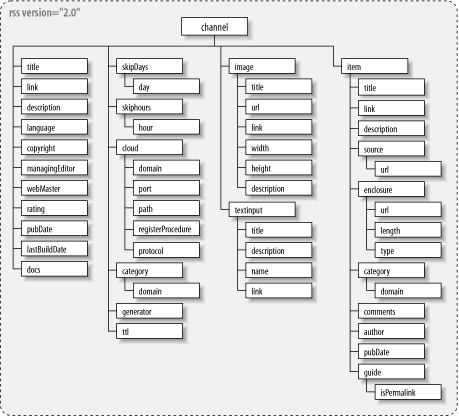RSS 2.0
With RSS 2.0, Dave Winer and Userland Software declared the simpler strand of the RSS specification frozen. Small point releases (2.0.1, 2.0.2, etc.) might be made to clarify matters, but for all intents and purposes, development of simple RSS ended with Version 2.0.
This is not to say that RSS 2.0 cannot be extended, however. Taking its cue from the RSS 1.0 community’s use of XML namespaces, RSS 2.0 can be extended by the use of modules. Figure 3-3 shows a tree representation of RSS 2.0.

Figure 3-3. A tree representation of RSS 2.0
The Specification in Summary
XML-based, but in a more complex form than in previous versions.
Modularized, providing massive extensibility but also additional complexity.
Based on (and the last of) the simple RSS strand.
Example 3-3 is an example of RSS 2.0.
Example 3-3. An example of RSS 2.0
<rss version="2.0" xmlns:dc="http://purl.org/dc/elements/1.1/"> <channel> <title>RSS2.0Example</title> <link>http://www.exampleurl.com/example/index.html</link> <description>This is an example RSS 2.0 feed</description> <language>en-gb</language> <copyright>Copyright 2002, Oreilly and Associates.</copyright> <managingEditor>example@exampleurl.com</managingEditor> <webMaster>webmaster@exampleurl.com</webMaster> <rating> </rating> <pubDate>03 Apr 02 1500 GMT</pubDate> <lastBuildDate>03 Apr 02 1500 GMT</lastBuildDate> <docs>http://backend.userland.com/rss</docs> ...
Get Content Syndication with RSS now with the O’Reilly learning platform.
O’Reilly members experience books, live events, courses curated by job role, and more from O’Reilly and nearly 200 top publishers.

